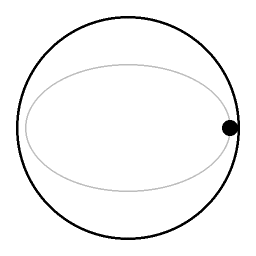User:Cleonis/Sandbox/Coriolis coupling





The animations on this talk page have in common the theme that there is a centripetal force that is sustaining a rotation, and the rotaton is combined with an oscillation in the distance to the center of rotation. Because the distance to the center of rotation is not fixed there are Coriolis effects.
The motion of the circling masses connected by a spring is in two dimensions. This motion in two dimensions can be decomposed in two harmonic oscillations, perpendicular to each other.
The following parametric equation of the position as a function of time describes the motion of the circling masses:
- (1)
- (2)
- Notation:
- is half the length of the major axis
- is half the length of the minor axis
- is 360 ° divided by the duration of one revolution
The motion as a function of time can be also be seen as a vector combination of two uniform circular motions. The parametric equations (1) and (2) can be rewritten as:
A transformation to a coordinate system that subtracts the overall circular motion leaves the eccentricity of the elliptical orbit:
The animations of an object moving frictionless over the surface of a parabolic disk are schematized versions of the MIT physical demonstratons of motion over the surface of a parabolic dish.
Geophysics
[edit]

In Oceanography there is the concept of 'inertia oscillations'. These inertia oscillations can be understood by noting the analogy with other examples of rotation combined with oscillation in the distance to the center of rotation.
For example, an inertia oscillation of ocean water is stirred up if a steady wind has been blowing for several days, imparting a velocity to the water. After the wind has subsided, some velocity of the water with respect to the earth remains. Instruments that track the position of buoys show that a substantial body of water is oscillating in a circle with a diameter of several kilometers. (The circle with several kilometers diameter is the component of the motion with respect to the Earth.)

The dynamis of the atmosphere is affected by the fact that is it rotating. For example: air mass that is flowing from east to west will tend to veer towards the nearest pole because of the poleward force. In all the consequence is that winds tend to remain circulating around a low pressure area, instead of leveling the pressure gradient.
On a non-rotating planet, the air would simply rush in from all sides.









